The State Government of Victoria recently released ‘Plan Melbourne’, a comprehensive document outlining detailed plans for the growth and development of Greater Melbourne. This blueprint provided investors with an outstanding insight into the future of Melbourne,e offering forecasts on population, employment and infrastructure growth.
Issued in May 2014, Plan Melbourne is the “Victorian Government’s metropolitan planning strategy, guiding the way the city will grow and change over the next 40 years. It is a strategy to house, employ and connect more people to jobs and services closer to where they live… Plan Melbourne provides communities with clear direction about the future of their neighbourhoods, identifies areas that can accommodate future growth and seeks to build a vibrant central city core.”
Let’s summarise the key areas of the document:
POPULATION
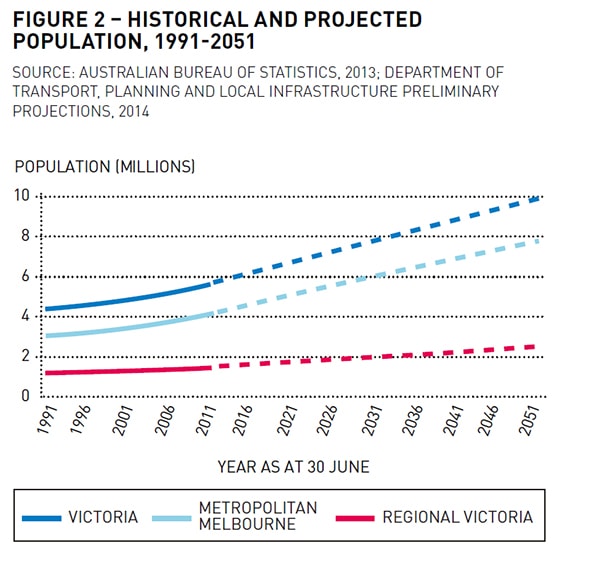
Melbourne is forecast to grow to a city of around 7.7 million people by 2051 – adding 3.4 million to today’s population and making Victoria home to around 10 million people. This means that we will need to accommodate around 90,000 new residents in Melbourne every year, rather than the 75,000 people per year over the past decade.
The Southern and Northern regions of Melbourne are forecast to grow by the largest amount, with an estimated 400,000 – 480,000 surge in population by 2031.
EMPLOYMENT
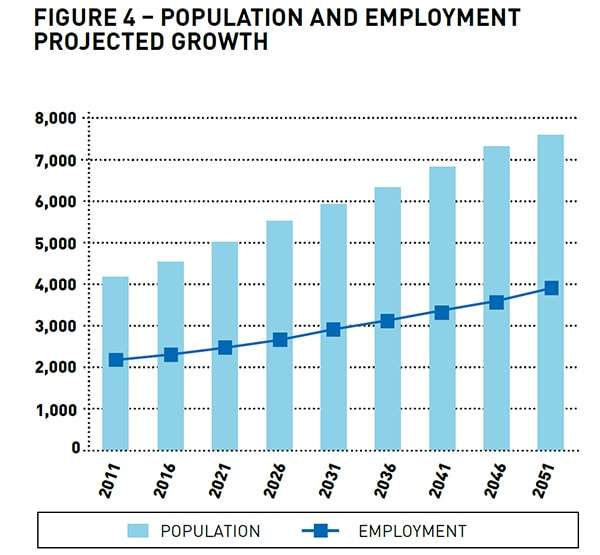
Greater Melbourne is expected to create 1.7 million new jobs by 2051, adding to its current 2 million jobs. The City of Melbourne, which includes the central city, is set to become Australia’s largest business centre and projected to grow from 435,000 jobs in 2011 to almost 900,000 jobs by 2051. It is planned that the city will expand to other closely located precincts such as South Yarra, Parkville, Footscray, and Fishermans Bend.
The distribution of jobs across Melbourne is uneven and outer suburbs generally have poorer access to jobs than middle and inner Melbourne. For example, in the outer-west and outer south- east, there are only about four jobs for every 10 working age residents. Six places have been identified as ‘national employment clusters’, that can, or have the potential to, provide high job concentrations in suburban locations.
EXISTING
The Monash Cluster
The Parkville Cluster
The Dandenong South Cluster
EMERGIN
The East Werribee Cluster
The Sunshine Cluster
The La Trobe Cluster
INTEGRATED ECONOMIC TRIANGLE
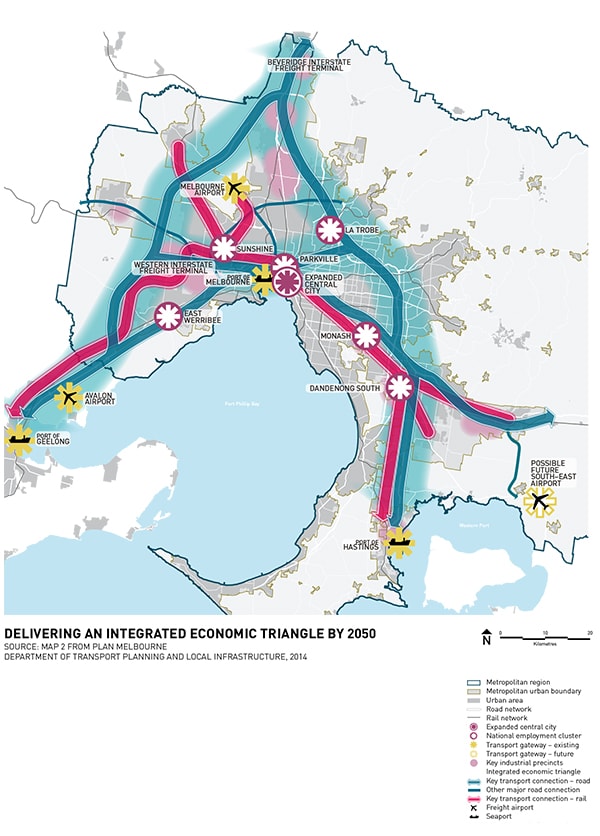
Plan Melbourne will help guide the evolution of an integrated economic network by 2050. Melbourne’s productive employment centres will be located around an enhanced transport network. This will link an expanded central city, national employment clusters and state-significant industrial precincts. This has given birth to the concept of an ‘Integrated Economic Triangle’, designed to create increased options for investment and jobs along existing and future transport corridors.
The Integrated Economic Triangle will connect the Hastings-Dandenong corridor with the Hume corridor to the north and the Wyndham-Geelong corridor to the south-west.
Each ‘point’ of the triangle is proposed to have its own port, airport and rail links, which means that the industrial load can be dispersed across Melbourne rather than heavy reliance on existing, centralised infrastructure. By sharing the load, Greater Melbourne can achieve an even coverage of employment and industry, yet connected by advanced transport network so that each sector can connect. For investors, this means that employment growth will focussed around the threes parts of the Integrated Economic Triangle, generated by the inflow of new business to the area, aswell as the infrastructure construction.
METROPOLITAN ACTIVITY CENTRES
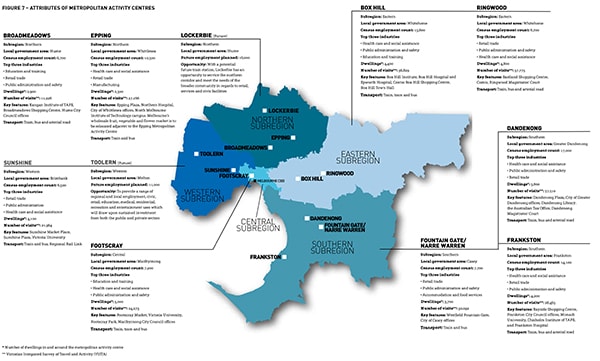
Continuing the theme of ‘less reliance’ on Melbourne’s CBD, Plan Melbourne talks of an expanded central city through the emegergence and creation of ‘Metropoltan Activity Centres’. These centres will open up Melbourne towards the outer suburbs, reducing the congestion and reliance on Melbourne’s CBD.
Metropolitan Activity Centres are the “highest priority areas for commercial and residential development outside of the Central Business District (CBD), and will undergo a substantial amount of new infrastructure and investment.” As a result, they will areas set for strong house price growth in the future, as employment and population increases.
Existing metropolitan activity centres include:
• Dandenong
• Footscray
• Fountain Gate/Narre Warren
• Epping
• Sunshine
• Ringwood
• Broadmeadows
• Box Hill
• Frankston
Future emerging metropolitan activity centres:
• Toolern
• Lockerbie
INFRASTRUCTURE
The government will invest billions of dollars on major infrastructure planned to support the key concepts of the Integrated Economic Triangle and expanded central city. These can be summarised as:
- Port of Hastings
- East West Link and North East Link
- Melbourne Rail Link (including the Airport Rail Link)
- Cranbourne-Pakenham Rail Corridor Project
- Outer Metropolitan Ring Road
- CityLink-Tulla widening
- potential South East Rail Link
- potential South East airport
- potential Western Interstate Freight Terminal
- potential Beveridge Interstate Freight Terminal
HOUSING SUPPLY
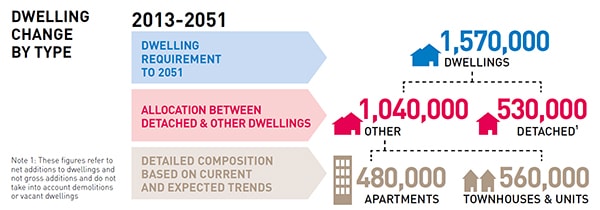
Melbourne has been the fastest growing Australian city for 11 years in a row, growing its population by over 600,000 people. Plan Melbourne’s forecasted growth will mean Melbourne will have to accommodate 90,000 new residents each year, requiring 1.6million more dwellings than the city has today. This is excellent news for investors, with property a commodity that will be in heavy demand over time. The planned increase in townhouses and units is also important, noting that land will not be a primary concern for Plan Melbourne’s need to increase housing supply
SUMMARY
- Plan Melbourne is the State Governments blueprint for Melbourne’s population, employment, transport, housing and environment future.
- Melbourne’s population is forecast to be 7.7 million, by 2051
- Melbourne’s housing supply is forecasted to be 1.6million more dwellings than today, by 2051
- Development of an Integrated Economic Triangle: three distinct areas of major employment and industry, connected by an improved road and rail network
- Expanding the CBD to reduce residential and industrial reliance on inner-Melbourne, by creating suburban ‘Metropolitan Activity Centres’ and ‘National Employment Clusters’
Learn how to take advantage by investing in property
Book an appointment
Sources:
“Plan Melbourne” (2014) State of Victoria. Authorised and published by the Victorian Government, 1 Treasury Place, Melbourne Victoria 3000.
“Know Your Plan Melbourne” (2014) State of Victoria. Authorised and published by the Victorian Government, 1 Treasury Place, Melbourne Victoria 3000.